Haodong Li
Depth Any Panoramas: A Foundation Model for Panoramic Depth Estimation
Dec 18, 2025



Abstract:In this work, we present a panoramic metric depth foundation model that generalizes across diverse scene distances. We explore a data-in-the-loop paradigm from the view of both data construction and framework design. We collect a large-scale dataset by combining public datasets, high-quality synthetic data from our UE5 simulator and text-to-image models, and real panoramic images from the web. To reduce domain gaps between indoor/outdoor and synthetic/real data, we introduce a three-stage pseudo-label curation pipeline to generate reliable ground truth for unlabeled images. For the model, we adopt DINOv3-Large as the backbone for its strong pre-trained generalization, and introduce a plug-and-play range mask head, sharpness-centric optimization, and geometry-centric optimization to improve robustness to varying distances and enforce geometric consistency across views. Experiments on multiple benchmarks (e.g., Stanford2D3D, Matterport3D, and Deep360) demonstrate strong performance and zero-shot generalization, with particularly robust and stable metric predictions in diverse real-world scenes. The project page can be found at: \href{https://insta360-research-team.github.io/DAP_website/} {https://insta360-research-team.github.io/DAP\_website/}
As If We've Met Before: LLMs Exhibit Certainty in Recognizing Seen Files
Nov 19, 2025Abstract:The remarkable language ability of Large Language Models (LLMs) stems from extensive training on vast datasets, often including copyrighted material, which raises serious concerns about unauthorized use. While Membership Inference Attacks (MIAs) offer potential solutions for detecting such violations, existing approaches face critical limitations and challenges due to LLMs' inherent overconfidence, limited access to ground truth training data, and reliance on empirically determined thresholds. We present COPYCHECK, a novel framework that leverages uncertainty signals to detect whether copyrighted content was used in LLM training sets. Our method turns LLM overconfidence from a limitation into an asset by capturing uncertainty patterns that reliably distinguish between ``seen" (training data) and ``unseen" (non-training data) content. COPYCHECK further implements a two-fold strategy: (1) strategic segmentation of files into smaller snippets to reduce dependence on large-scale training data, and (2) uncertainty-guided unsupervised clustering to eliminate the need for empirically tuned thresholds. Experiment results show that COPYCHECK achieves an average balanced accuracy of 90.1% on LLaMA 7b and 91.6% on LLaMA2 7b in detecting seen files. Compared to the SOTA baseline, COPYCHECK achieves over 90% relative improvement, reaching up to 93.8\% balanced accuracy. It further exhibits strong generalizability across architectures, maintaining high performance on GPT-J 6B. This work presents the first application of uncertainty for copyright detection in LLMs, offering practical tools for training data transparency.
DA$^2$: Depth Anything in Any Direction
Sep 30, 2025Abstract:Panorama has a full FoV (360$^\circ\times$180$^\circ$), offering a more complete visual description than perspective images. Thanks to this characteristic, panoramic depth estimation is gaining increasing traction in 3D vision. However, due to the scarcity of panoramic data, previous methods are often restricted to in-domain settings, leading to poor zero-shot generalization. Furthermore, due to the spherical distortions inherent in panoramas, many approaches rely on perspective splitting (e.g., cubemaps), which leads to suboptimal efficiency. To address these challenges, we propose $\textbf{DA}$$^{\textbf{2}}$: $\textbf{D}$epth $\textbf{A}$nything in $\textbf{A}$ny $\textbf{D}$irection, an accurate, zero-shot generalizable, and fully end-to-end panoramic depth estimator. Specifically, for scaling up panoramic data, we introduce a data curation engine for generating high-quality panoramic depth data from perspective, and create $\sim$543K panoramic RGB-depth pairs, bringing the total to $\sim$607K. To further mitigate the spherical distortions, we present SphereViT, which explicitly leverages spherical coordinates to enforce the spherical geometric consistency in panoramic image features, yielding improved performance. A comprehensive benchmark on multiple datasets clearly demonstrates DA$^{2}$'s SoTA performance, with an average 38% improvement on AbsRel over the strongest zero-shot baseline. Surprisingly, DA$^{2}$ even outperforms prior in-domain methods, highlighting its superior zero-shot generalization. Moreover, as an end-to-end solution, DA$^{2}$ exhibits much higher efficiency over fusion-based approaches. Both the code and the curated panoramic data will be released. Project page: https://depth-any-in-any-dir.github.io/.
LCS-CTC: Leveraging Soft Alignments to Enhance Phonetic Transcription Robustness
Aug 05, 2025Abstract:Phonetic speech transcription is crucial for fine-grained linguistic analysis and downstream speech applications. While Connectionist Temporal Classification (CTC) is a widely used approach for such tasks due to its efficiency, it often falls short in recognition performance, especially under unclear and nonfluent speech. In this work, we propose LCS-CTC, a two-stage framework for phoneme-level speech recognition that combines a similarity-aware local alignment algorithm with a constrained CTC training objective. By predicting fine-grained frame-phoneme cost matrices and applying a modified Longest Common Subsequence (LCS) algorithm, our method identifies high-confidence alignment zones which are used to constrain the CTC decoding path space, thereby reducing overfitting and improving generalization ability, which enables both robust recognition and text-free forced alignment. Experiments on both LibriSpeech and PPA demonstrate that LCS-CTC consistently outperforms vanilla CTC baselines, suggesting its potential to unify phoneme modeling across fluent and non-fluent speech.
StereoDiff: Stereo-Diffusion Synergy for Video Depth Estimation
Jun 25, 2025



Abstract:Recent video depth estimation methods achieve great performance by following the paradigm of image depth estimation, i.e., typically fine-tuning pre-trained video diffusion models with massive data. However, we argue that video depth estimation is not a naive extension of image depth estimation. The temporal consistency requirements for dynamic and static regions in videos are fundamentally different. Consistent video depth in static regions, typically backgrounds, can be more effectively achieved via stereo matching across all frames, which provides much stronger global 3D cues. While the consistency for dynamic regions still should be learned from large-scale video depth data to ensure smooth transitions, due to the violation of triangulation constraints. Based on these insights, we introduce StereoDiff, a two-stage video depth estimator that synergizes stereo matching for mainly the static areas with video depth diffusion for maintaining consistent depth transitions in dynamic areas. We mathematically demonstrate how stereo matching and video depth diffusion offer complementary strengths through frequency domain analysis, highlighting the effectiveness of their synergy in capturing the advantages of both. Experimental results on zero-shot, real-world, dynamic video depth benchmarks, both indoor and outdoor, demonstrate StereoDiff's SoTA performance, showcasing its superior consistency and accuracy in video depth estimation.
Advancing high-fidelity 3D and Texture Generation with 2.5D latents
May 28, 2025Abstract:Despite the availability of large-scale 3D datasets and advancements in 3D generative models, the complexity and uneven quality of 3D geometry and texture data continue to hinder the performance of 3D generation techniques. In most existing approaches, 3D geometry and texture are generated in separate stages using different models and non-unified representations, frequently leading to unsatisfactory coherence between geometry and texture. To address these challenges, we propose a novel framework for joint generation of 3D geometry and texture. Specifically, we focus in generate a versatile 2.5D representations that can be seamlessly transformed between 2D and 3D. Our approach begins by integrating multiview RGB, normal, and coordinate images into a unified representation, termed as 2.5D latents. Next, we adapt pre-trained 2D foundation models for high-fidelity 2.5D generation, utilizing both text and image conditions. Finally, we introduce a lightweight 2.5D-to-3D refiner-decoder framework that efficiently generates detailed 3D representations from 2.5D images. Extensive experiments demonstrate that our model not only excels in generating high-quality 3D objects with coherent structure and color from text and image inputs but also significantly outperforms existing methods in geometry-conditioned texture generation.
Jasmine: Harnessing Diffusion Prior for Self-supervised Depth Estimation
Mar 20, 2025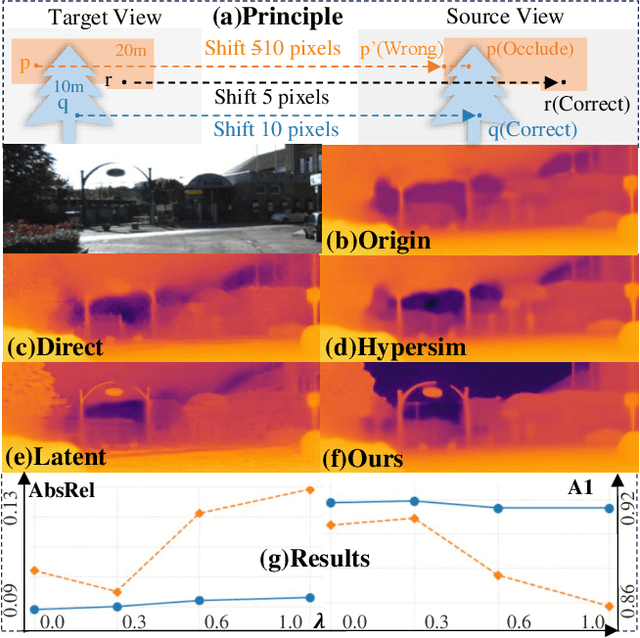
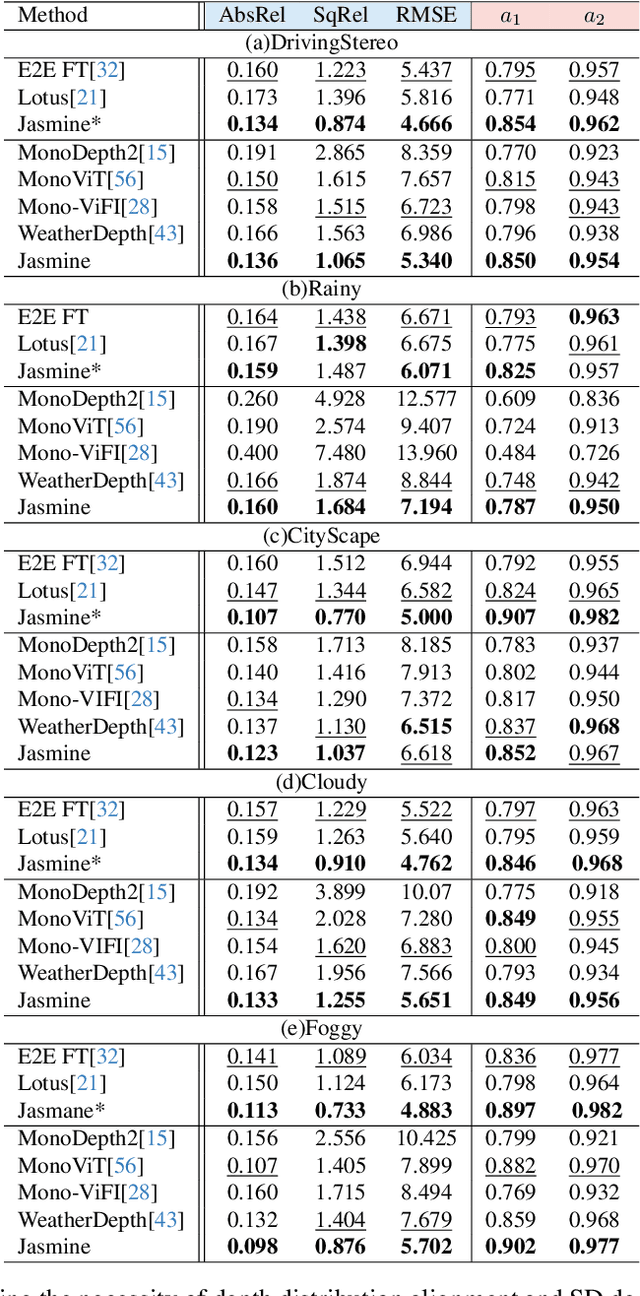

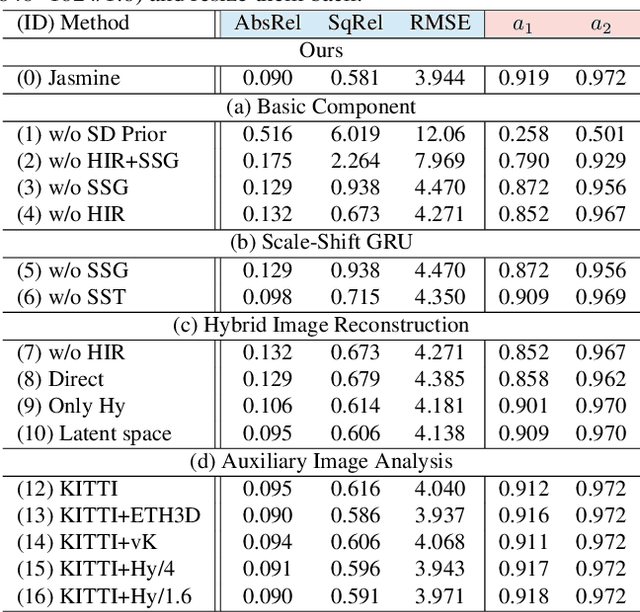
Abstract:In this paper, we propose Jasmine, the first Stable Diffusion (SD)-based self-supervised framework for monocular depth estimation, which effectively harnesses SD's visual priors to enhance the sharpness and generalization of unsupervised prediction. Previous SD-based methods are all supervised since adapting diffusion models for dense prediction requires high-precision supervision. In contrast, self-supervised reprojection suffers from inherent challenges (e.g., occlusions, texture-less regions, illumination variance), and the predictions exhibit blurs and artifacts that severely compromise SD's latent priors. To resolve this, we construct a novel surrogate task of hybrid image reconstruction. Without any additional supervision, it preserves the detail priors of SD models by reconstructing the images themselves while preventing depth estimation from degradation. Furthermore, to address the inherent misalignment between SD's scale and shift invariant estimation and self-supervised scale-invariant depth estimation, we build the Scale-Shift GRU. It not only bridges this distribution gap but also isolates the fine-grained texture of SD output against the interference of reprojection loss. Extensive experiments demonstrate that Jasmine achieves SoTA performance on the KITTI benchmark and exhibits superior zero-shot generalization across multiple datasets.
DDFAV: Remote Sensing Large Vision Language Models Dataset and Evaluation Benchmark
Nov 05, 2024Abstract:With the rapid development of large vision language models (LVLMs), these models have shown excellent results in various multimodal tasks. Since LVLMs are prone to hallucinations and there are currently few datasets and evaluation methods specifically designed for remote sensing, their performance is typically poor when applied to remote sensing tasks. To address these issues, this paper introduces a high quality remote sensing LVLMs dataset, DDFAV, created using data augmentation and data mixing strategies. Next, a training instruction set is produced based on some high-quality remote sensing images selected from the proposed dataset. Finally, we develop a remote sensing LVLMs hallucination evaluation method RSPOPE based on the proposed dataset and evaluate the zero-shot capabilities of different LVLMs. Our proposed dataset, instruction set, and evaluation method files are available at https://github.com/HaodongLi2024/rspope.
DOME: Taming Diffusion Model into High-Fidelity Controllable Occupancy World Model
Oct 14, 2024

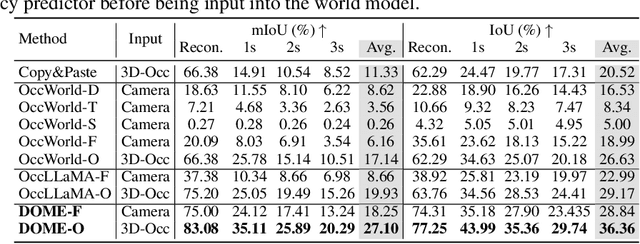
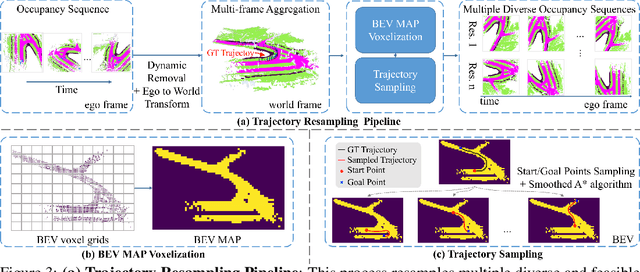
Abstract:We propose DOME, a diffusion-based world model that predicts future occupancy frames based on past occupancy observations. The ability of this world model to capture the evolution of the environment is crucial for planning in autonomous driving. Compared to 2D video-based world models, the occupancy world model utilizes a native 3D representation, which features easily obtainable annotations and is modality-agnostic. This flexibility has the potential to facilitate the development of more advanced world models. Existing occupancy world models either suffer from detail loss due to discrete tokenization or rely on simplistic diffusion architectures, leading to inefficiencies and difficulties in predicting future occupancy with controllability. Our DOME exhibits two key features:(1) High-Fidelity and Long-Duration Generation. We adopt a spatial-temporal diffusion transformer to predict future occupancy frames based on historical context. This architecture efficiently captures spatial-temporal information, enabling high-fidelity details and the ability to generate predictions over long durations. (2)Fine-grained Controllability. We address the challenge of controllability in predictions by introducing a trajectory resampling method, which significantly enhances the model's ability to generate controlled predictions. Extensive experiments on the widely used nuScenes dataset demonstrate that our method surpasses existing baselines in both qualitative and quantitative evaluations, establishing a new state-of-the-art performance on nuScenes. Specifically, our approach surpasses the baseline by 10.5% in mIoU and 21.2% in IoU for occupancy reconstruction and by 36.0% in mIoU and 24.6% in IoU for 4D occupancy forecasting.
DisEnvisioner: Disentangled and Enriched Visual Prompt for Customized Image Generation
Oct 02, 2024Abstract:In the realm of image generation, creating customized images from visual prompt with additional textual instruction emerges as a promising endeavor. However, existing methods, both tuning-based and tuning-free, struggle with interpreting the subject-essential attributes from the visual prompt. This leads to subject-irrelevant attributes infiltrating the generation process, ultimately compromising the personalization quality in both editability and ID preservation. In this paper, we present DisEnvisioner, a novel approach for effectively extracting and enriching the subject-essential features while filtering out -irrelevant information, enabling exceptional customization performance, in a tuning-free manner and using only a single image. Specifically, the feature of the subject and other irrelevant components are effectively separated into distinctive visual tokens, enabling a much more accurate customization. Aiming to further improving the ID consistency, we enrich the disentangled features, sculpting them into more granular representations. Experiments demonstrate the superiority of our approach over existing methods in instruction response (editability), ID consistency, inference speed, and the overall image quality, highlighting the effectiveness and efficiency of DisEnvisioner. Project page: https://disenvisioner.github.io/.
 Add to Chrome
Add to Chrome Add to Firefox
Add to Firefox Add to Edge
Add to Edge